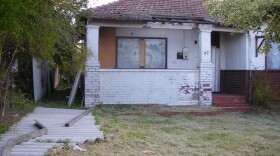Dallas has more than 100 square miles of blighted neighborhoods. That’s 16 percent of the city. Officials from the city and community organizations got together Thursday to talk about how to rescue and revitalize those neighborhoods.
Jamal Rahim says the city needs to use a wrecking ball to revive his neighborhood -- populated by abandoned buildings.
“It’s the buildings," Rahim said, waiting for a bus on Martin Luther King Boulevard. "Once you get the buildings did, people will come back. Once a building is boarded up and stuff, they don’t have no reason to come.”
Down the street, Tina James says it’s not just abandoned houses. It’s people and their problems, too.
“There’s a lot of old houses over here that probably were owned by parents that are not around anymore," James said. "And people are on drugs living in their parents’ houses, paid for. And then they get run down and then there you go, snowball from there.”
This Fair Park neighborhood is among the high blight areas identified in a new University of North Texas blight index. The majority are in South Dallas.

So, what is blight? UNT researcher Sudha Arlikatti says the definition has changed over the years. She told the large crowd of city officials and non-profit organizations that it’s more than broken windows and boarded-up buildings.
“Crime and vandalism, quality of life," Arlikatti told the crowd at the Communities Foundation of Texas. "Do you feel safe? Do you feel that your kids can get a better education? Do you have a health system?”
The so-called composite blight index uses data on the number of vacant, abandoned, foreclosed, or tax delinquent properties, code violations and property values; plus information on poverty, unemployment, race, education, crime.
Dallas Mayor Mike Rawlings says the cost to the city is high.
“We spend over $2 million dollars of taxpayers’ money mowing lawns in blighted areas because we’re trying to keep this thing clean," Rawlings said. "Now, there’s got to be a better way than us sending lawn mowers out and mowing things.”
Over the past two years, the city has filed $10 million in liens against properties for city mowing, boarding-up and demolition. But has collected only about a tenth of that.
Rawlings challenged the group to use the information in the blight index to come up with new, comprehensive ways to attack the problems: from high weeds and litter, to overdue property taxes, plus education and jobs.
Dallas Area Habitat for Humanity CEO Bill Hall says the index, updated each year, can also measure progress. He says blight is not just an isolated neighborhood problem. It holds back investment, and that costs the entire city.
Hall and others have formed a new group called EPIC, Economic Partners Investing In Communities. The don’t have a plan yet for tackling blight, but with the new index they have a starting point.



